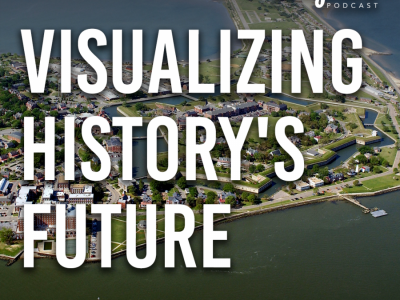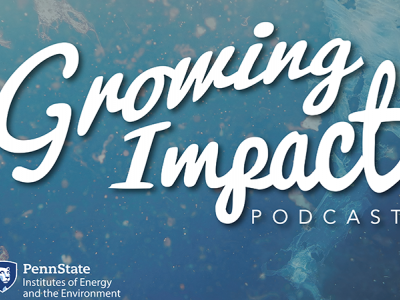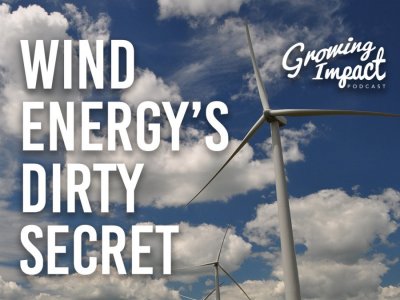Plastic of all shapes and sizes is showing up in bodies of water around the world, including microplastics, which are 5mm or less in size. But how these tiny pieces of plastic move through water and what impacts that movement is still a bit of a mystery. This includes biofilms, the thin layers of organisms that build up on material found in water.
Transcript
INTRO: It is really fascinating how much there could be in such a seemingly simple thing: how does a piece of plastic fall through water? You have to think about so much. You have to think about what is the surface property of that piece of plastic and what’s its shape and how big is it and how dense is it—because all different kinds of plastics have different densities, some of them float and some of them sink, and you have to think about so much as just one simple question.
HOST: Welcome to Growing Impact, a podcast by the Institutes of Energy and the Environment at Penn State. Growing Impact explores cutting-edge projects of researchers and scientists, who are solving some of the world's most challenging energy and environmental issues. Each project has been funded through an innovative seed grant program that is facilitated through IEE. I'm your host, Kevin Sliman. On this episode of Growing Impact, I speak with Margaret Byron, an assistant professor of mechanical engineering, who studies the transport of organisms and objects in environmental flows. We discuss her seed grant project titled “Effects of Biofilms on the Transport of Microplastics,” where she and her colleagues are investigating how tiny pieces of plastic, no larger than the width of a pencil, move through water after sticky, slimy, and growing microorganisms and other creatures attach to those plastics.
HOST: Thank you for joining us on Growing Impact today, Margaret, and welcome to the show.
Margaret Byron (MB): Thank you so much. Pleasure to be here.
HOST: What are microplastics and how are they becoming such an urgent issue when it comes to pollution?
MB: Microplastics are small fragments of plastic, and these can enter the environment, either already small or they can result from the breakdown of larger items. So we've all seen pictures of plastic debris in the ocean and it's like fishing nets and things like that. Of course, that's one way that plastic enters our waterways. But in other ways, as we might have fibers that come off of your clothing in, in the washing machine and wash out into the water supply. We might have atmospheric dust settling out over rivers and oceans that contains pieces of plastic that blew up into the air somehow. Pieces of rubber that wear off your tires on the road and things like that. These pieces of plastic are somewhat ubiquitous. We found them everywhere, from the bottom of the deepest ocean trenches to really remote areas around the poles even. So these plastics, one of the problems here is that we're not quite sure what the overall impact of these. We know that they're not really supposed to be there. But there's a lot of debate about what might cause what, in terms of the presence of plastics leading to impacts on our ecosystem and health.

HOST: What kind of impacts are we looking at when we talk about environmental health?
MB: Yeah, So we have all kinds of impacts from animals mistaking plastic for food. That can be pretty catastrophic. These plastics have even made their way into our own food and water supply. By one estimate, we are ingesting up to a credit card worth of plastic every week. Crazy. Yes.
HOST: Astonishing.
MB: And you know, that's the upper bounds on the estimate. But, but yeah, so a lot of these are so small that that we don't look at them and we don't see them. I tend to work with plastics that are on the upper end of the range that we would consider microplastics. Microplastics are anything that's less than five millimeters. And of course you can get really small nano plastics as well. But one thing that's interesting about these sub five millimeter pieces that they get transported pretty easily. So if you have a flowing water system, it would be really beneficial for us to know exactly how those plastics are going to be carried around by that moving water. And that's really kind of what we're looking at in our study.
HOST: For listeners who are like five millimeters, What's five millimeters? Is there any way that we could add or think about something that's like, oh five millimeters.
MB: That probably be about the diameter of a number two pencil maybe.
HOST: Okay.
MB: Maybe a little bit less. But yeah, that's a good point, right? Just try to ballpark it. I see it's still visible until the end until we get down to really small. But it's small enough that you can imagine if I, if I put that in a river, it will kind of go with the flow. But it doesn’t exactly go with the flow. And hopefully we'll talk about that in a second.
HOST: Yeah. In the title of your title of your research, you're talking about biofilms. Educate me, tell me what biofilms are.
MB: If you've ever been to the coast and you've seen a buoy or the bottom of a boat or something like that, it doesn't look like a pristine surface. There’s stuff growing on it, barnacles and algae and stuff like that. So if you think of that, writ small, so you have a little piece of plastic and it gets into the water somehow. My graduate student hasn't really useful phrase that she uses. She says that the plastic becomes part of the environment. It becomes an active participant in the environment, because there are all kinds of organisms, bacteria, algae, larvae, of animals that live in those kinds of ecosystems. They like to attach to things. So normally that would be rocks or the bottom of the river, bottom of the ocean. But if there is a piece of plastic handy, maybe they should settle their instead. And so what happens is this piece of plastic which otherwise would have been clean, starts having thin films of colonies of bacteria, maybe algae and maybe larger organisms will attach to that surface. And that can affect how that piece of plastic might move in the water. You can imagine if its got a barnacle attached to one side. Maybe it's bottom heavy. Or if it's got bacteria growing on it, maybe it's little gooey, a little slimy and that changes how it bumps into things and how it might attach to different obstacles that it bumps it to along the way. So we're pretty interested in that side of it and how the physical properties of this plastic get changed once it is an active participant in an ecosystem like that, right? So does that change, for example, how fast it settles down to the bottom? Right? Does that change how far it goes before it settles out to the bottom? If it ever settles out to the bottom because we need to know these plastics if they're in the environment, when do they leave? How did they leave? How does stuff get beached? How does it continue floating and where does it go? These are all questions of what we would call physical transport. And, and so we're trying to figure out how some of these biological properties affect this physical transport.
HOST: Currently, there's not a lot of data and not a lot of knowledge in this area. This is, so your work right now is kind of leading the way. Maybe not leading the way. I don’t know how you want to phrase it.
MB: I would say it’s a growing field
HOST: OK, growing field. I like that.
MB: It's tough because it's hard to say microplastics are new, they're not new. We've been using plastic. I mean, microplastic pollution has existed since we had been using plastic, which has been a long time now. I think as a society we've started to depend more and more on plastic. And you can think of kind of classic villain things like plastic packaging. But you can also think of stuff like medical waste and useful technology that uses plastic by necessity. And there are certainly many, many ways that we can try to reduce our dependence on plastic pollution. But in the meantime, we have this stream of plastic waste and a significant fraction of it is going to end up in the environment somehow, hopefully in a landfill or in another controlled way, maybe recycled but we have these entry points of plastic into the environments. And so this is obviously something that's been happening for a while. But our ability to measure it in our awareness has a society like holy crap, there's plastic everywhere. I feel like that has been over the past 10 years, maybe really, really expanded. And I think there's a pattern that any new scientific field takes, which is, let's learn everything we can about this and then maybe converge on some common ground. So you see a lot of literature on we found these microplastics. They’re this kind, and they were over here, right? I would say a lot of papers get published of we went sampling for plastics, and look this is what we found. So we're starting to get to that level of knowledge now where we can start putting that information together to think about things like, okay, well, if it started out here and we found it over here, what does that mean for what happened to it in between, and could use that information to make predictions that are useful to us to help solve the problem? Which is of course, we want less plastic in the environment. Whether that means removing it, which is actually really, really difficult, or whether that means prioritizing different kinds of mitigation? Is it more important for us to try to control this entry point versus this entry point. Those are the kinds of questions we’re trying to indirectly answer.
HOST: What led experts like yourself to investigate biofilms as the way, in a way that they're impacting microplastics in the first place?
MB: My background actually is in a field called particle laden flow, which is exactly what it sounds like. If you have lots of flows we're interested in especially flows in the environment have stuff in them. And a lot of times that stuff is small enough to be transported some distance by default. But there are all kinds of brushes that rise saying, okay, we have that classic joke is when you ask a physicist, right? Why did the chicken cross the road? The physicist first says, Well, imagine a spherical chicken in a vacuum. As scientists and as engineers, we want to make those simplifications kind of a first-order guess of what's going on. But the particles that are in these flows that we care about one category at those particles would be microplastics. They're not spheres, right? They're not perfect. They're really irregular. Even just with microplastics, you can think about fibers and films like a little piece of plastic grocery bag. You can think about fragments of a larger object. You can think about little plastic pellets that are the raw material that's used to make goods. Those are called nurdles, which is one of my favorite words. So there's a huge variety of shape and size. Earlier in my career and still to this day, I was very interested in these questions of size and shape and how the size and the shape of an object impacted how it was transported by environmental flows. And one thing that I had been thinking about recently is okay, well what happens if that particle is heavier on one side and lighter on one side? And we would say the mass distribution, what happens if something is irregularly shaped and also irregularly composed. It has made of maybe one material on this side and another material, you can think of two things that are stuck together. So if I have a particle like that, how is that different from a particle whose composition is more uniform? And that got me thinking about microplastics in terms of what causes them to be un-uniform. And a lot of plastics are positively buoyant, which means maybe they're being subject to different levels of being degraded. You know plastics get degraded by the sun. They have biofilm growing on them. And all this can lead to this kind of irregular distribution of their mass. And so I was interested in those questions. I thought about biofilms as a potential application area of that. And I reach out to a colleague of mine, Jay Reagan, who's in the Civil Engineering Department and he studies biofilms in a different context. He often works with biofilms in soil. But he knew kind of what I was trying to get at, and we had been looking for a piece to collaborate. So we started talking about biofilms on microplastics. And that was the kind of genesis of where the project came from. But that's really from a physics standpoint what we're interested in. What happens if a particle is heavier on one side, it lighter on another side? How does that change the velocity, the speed at which it settles through the water? And then how does that change these questions of transport?
HOST: How could this new knowledge help impact microplastic pollution?
MB: I think this is a really important point to make, and I don't want to look at the tree and lose the forest. Plastic pollution is a problem. And microplastic pollution is a big problem. And the solution to that problem is to stop using plastic. Full stop. And so when we're thinking about microplastics pollution, we think about projects that are focused on removing plastic. Those projects are good and that's laudable. But it's kind of like trying to mop up the spill while the faucet is still on. All right, so the problem that we have to solve is reduce as a society, our reliance on plastic products and have better controls on what happens to those plastic products after we are done with them. So I want to make sure and that comes across because, you know, everything else is bean counting compared to that. But when we think about microplastic pollution in, from perspective are kind of small bite out of it, if I have a better idea, for example, of how fibers move in a river differently from fragments or differently from pellets or other shapes, then maybe if I think okay, well fibers are showing up most commonly. Maybe it's more important for us to use our perhaps limited financial capital, political capital to regulate that. Maybe my best use of resources is to provide households with filtration systems for their outlets for their washing machines. Maybe that's the best thing that I can do. If it's something else, maybe it's, maybe it's films or maybe we find that individual households are not really contributing very much at all to this problem. Maybe it's really all the plastic at the end of the day or almost all of it is coming from abandoned fishing gear. Well, that's going to call for a different mitigation strategy, right? And so all of our questions about transport, there are a lot less about how did we remove plastic from the environments and a lot more about if we can backtrack out how it got to where it is, can we prioritize how to turn off that spigot? Right. So yeah, I think that would be obviously a hugely downstream kind of effort from what we're doing here. But I think it's important to keep that goal in mind.
HOST: Any next steps or future plans that you can talk about for the project?
MB: Yes. I think we're going to expand a little bit from our initial goal of looking at the effects of biofilms and we might actually try to look at plastic degradation as well. And so we know that plastics don't really biodegrade in terms as organisms eating them. Although there are a select few. That's actually another proposed solution for the plastic pollution problem is plastic-eating microbes. That's not my area, so I won't go into it.
HOST: That sounds like a science horror movie.
MB: It really does But, I think plastic does get degraded in other ways. So it can be chemically degraded and photo degraded is a big one, right? UV degradation from the sun. And so we're going to maybe try to look into how those degradation effects can cause a different mass distribution, just like the biofilms may cause a different mass distribution. And so and again, I think we're going to try to expand into these surface propoerties. My core discipline is fluid dynamics, which is how air and water and other gases, liquids move around and the physics behind that. One key concept in fluid mechanics, it's the idea of a no slip condition. So if I have a fluid that's a liquid or a gas and it's flowing over a solid surface, the molecules in that fluid are more attracted to the solid surface than they are to each other. Let's imagine a wind blowing over a flat plate. And the molecules that are right next to that flat plate are going to stop because they're going to get stuck to that flat plate and the ones right above that are going to keep going, but they're going to have some friction on them. And so there's going to be a part of this, the speed near the plate is really reduce. And you can see this every time you go to the beach, right? Because if it's a windy day at the beach and want to get out of the wind, what do you do? You lie down in the sand.
HOST: You get low.
MB: Right. That would put you in what we call the boundary layer. And so this boundary layer ends up having kind of really important—it plays a really important role in terms of the forces on the particle. How big is that boundary layer? How much friction is there basically between a slow and the object? And so we think about a solid surface and a fluid as having that kind of relationship, this no slip relationship. But a biofilm is kind of a different animal. It's a layer of porous bacterial colonies and algae and whatnot. And it can be really thick and fluffy, can be dense and compact, but it's definitely not a solid surface. So how does that affect how the flow is going over the surface, right? And we would talk about drag, right? Just like you we talked about drag on a plane or a car, or even a tiny particle is going to experience drag, some kind of resistance to the flow that's trying to push it. And so we're really curious about then how the biofilm on a microplastic might change, how that relationship between a fluid and a solid surface develops. And that would tell us a little bit more again about how it's going to be transported. That would be another kind of future goal for this collaboration.
HOST: Thank you so much for spending time with us on Growing Impact and having such a great discussion on your research.
MB: Thank you again, and if anybody is interested in working with us, please don't hesitate to contact me.
HOST: You've been listening to Growing Impact, a podcast by the Institute of Energy and the Environment at Penn State. I've been your host, Kevin Sliman. This has been season two, episode 10. Thank you for listening.










